Another University Microgrid Goes Live, this One in Bridgeport, Connecticut
Another university microgrid is live, this one in Bridgeport, Connecticut, the latest as higher education continues to show itself as a lead mover in microgrids.
Download the Microgrid Knowledge Special Report: “Fuel Cell Microgrids: The Path to Lower Cost, Higher Reliability, Cleaner Energy.”
The University of Bridgeport (UB) microgrid uses a 1.4 MW fuel cell provided by Connecticut-based FuelCell Energy.
“This is a win-win for all,” said Neil Salonen, president of UB, which has 400 full and part-time students. “The much-anticipated installation of the new fuel cell on campus is cutting our energy costs, uses clean and efficient fuel cells that protect our students and the environment, and as a designated community shelter, provides critical energy to all.”
Some of the nation’s most noted microgrid projects can be found at colleges and universities, which were early adopters of the technology in the United States. Examples are Princeton University, the University of Texas at Austin, Harvard, Wesleyan University, Algonquin College, and the University California, San Diego.
Tour Harvard’s microgrid at Microgrid 2017, Nov. 6-8 in Boston.
Work on the UB microgrid began in 2014, when the university entered into a long-term agreement with FuelCell Energy to purchase power from the fuel cell installation. The agreement spared UB any capital investment and created an estimated $300,000 in savings annually for the university.
“Fuel cells are compelling for microgrids as they are clean, affordable, and unlike intermittent technologies, fuel cells supply continual power avoiding the need for peaking power support for back-up that intermittent technologies require to ensure power is available if the sun isn’t shining or the wind isn’t blowing.” said Chip Bottone, FuelCell Energy president and CEO.
FuelCell Energy operates and maintains the university microgrid and the fuel-cell. A/Z Corporation, also of Connecticut, designed and constructed modifications to UB’s medium-voltage electrical-distribution system and implemented a digital microgrid control system based on a Schweitzer Engineering Laboratories (SEL) controller.
The SEL microgrid controller automates the system and can detect a power outage, island from the local utility grid, and switch to fuel cell power. Buildings are completely shut off and then brought back on under the microgrid power once the fuel cell is ready.
The university microgrid received $2.2 million from Connecticut’s microgrid grant program.
“The University of Bridgeport microgrid project is a perfect example of the value of our microgrid grant program,” said Robert Klee, commissioner of Connecticut’s Department of Energy and Environmental Protection. “With the support of funding we have provided, this microgrid helps power the campus with reliable and affordable power on a 24/7 basis and also keeps critical faculties up and running to serve the campus and larger community in the event of a power outage.”
Read more about university microgrid projects by subscribing to the free Microgrid Knowledge newsletter or follow us on Twitter @MicrogridNews.
About the Author
Elisa Wood
Editor-in-Chief
Elisa Wood is the editor and founder of EnergyChangemakers.com. She is co-founder and former editor of Microgrid Knowledge.
